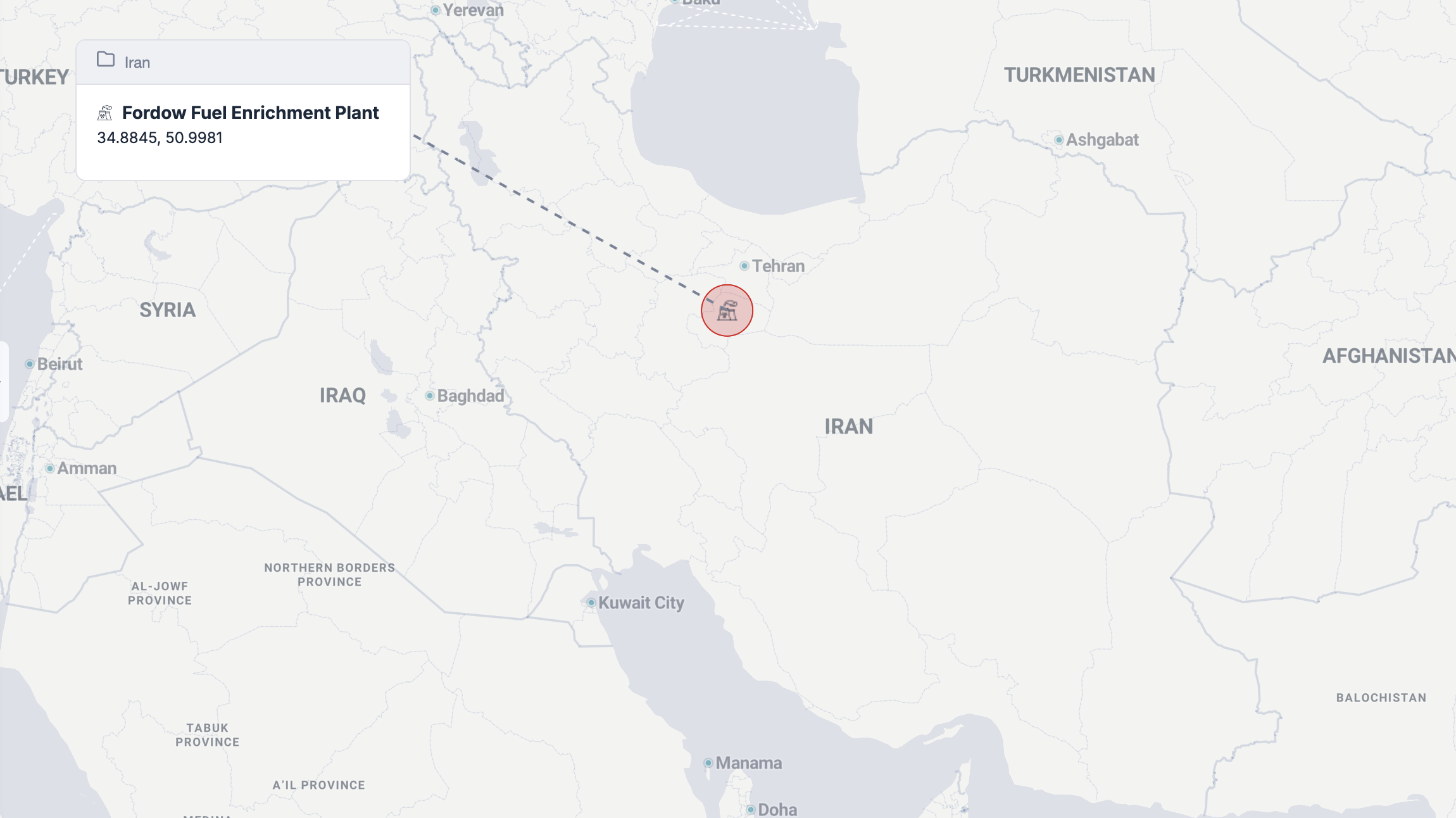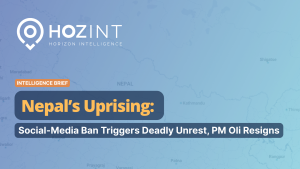Key Points
- On 22 June 2025, the United States launched precision airstrikes on Iran’s key nuclear facilities at Fordow, Natanz, and Isfahan, employing B-2 bombers and bunker-busting GBU-57 bombs.
- The Fordow Fuel Enrichment Plant, a deeply fortified site near Qom, was the primary target due to its role in Iran’s near-weapons-grade uranium production.
- This marks the first direct US military intervention in the Israel-Iran conflict, significantly escalating the crisis and drawing global attention.
- Iran has retaliated with missile attacks on Israel and is likely to respond further, including possible strikes on US forces or regional infrastructure.
- There are increasing risks to maritime security and global oil markets, particularly through threats to the Strait of Hormuz and renewed Houthi militancy.
Event Summary:
What: On 22 June 2025, the U.S. Air Force conducted precision airstrikes on three major Iranian nuclear sites: Fordow, Natanz, and Isfahan, targeting uranium enrichment infrastructure with B-2 stealth bombers and GBU-57 Massive Ordnance Penetrators (MOPs).
Who: The operation was ordered by President Donald Trump, citing an imminent Iranian nuclear breakout. The targets were under the control of the Atomic Energy Organisation of Iran (AEOI).
When: The strikes occurred early on 22 June 2025.
Where: Key strikes were conducted on deeply fortified underground nuclear sites, especially Fordow, located near the holy city of Qom.
Why: The Trump administration justified the action by claiming Iran was “weeks away” from building a nuclear weapon, although this claim contradicts U.S. intelligence estimates.
How: Using stealth B-2 bombers and the rare deployment of MOPs, 13.5-ton bombs capable of penetrating up to 60 meters underground, the U.S. delivered a highly specialised kinetic blow to disrupt Iran’s enrichment capabilities.
Analysis
The U.S. strike on Iran’s Fordow enrichment facility represents a watershed moment in the conflict that began with Israel’s Operation Rising Lion. While Israel previously targeted nuclear sites such as Natanz and Tehran-based military infrastructure, it lacked the capability to penetrate hardened bunkers like those at Fordow. The U.S. decision to deploy MOPs via B-2 bombers signals a shift from deterrence to active denial of nuclear capability.
The Fordow Fuel Enrichment Plant, also known as the Shahid Ali Mohammadi Nuclear Facility, is a fortified underground uranium enrichment site located approximately 30 km north of Qom, Iran, or more precisely at coordinates 34.8845, 50.9981.

Initially built in secret and disclosed to the IAEA only in 2009 after Western intelligence exposed its existence, Fordow has since been central to Iran’s nuclear ambitions. Constructed deep within a mountain to deter airstrikes, the facility houses up to 1,044 IR-1 centrifuges and has, in recent years, been linked to enrichment activities up to 83.7% U-235 purity, just below weapons-grade threshold. While initially repurposed under the Joint Comprehensive Plan of Action (JCPOA) for non-enrichment purposes, subsequent U.S. withdrawal from the deal in 2018 and Iranian non-compliance led to renewed activity at the site. Its proximity to the religiously significant city of Qom adds a volatile sectarian dimension to any attack on it.
From a tactical perspective, this was a rare deployment of America’s most powerful non-nuclear ordnance. The use of such force against a site buried deep in mountainous terrain reflects both the perceived urgency and the geopolitical stakes. The Pentagon’s calculation was that a direct strike could set back Iran’s nuclear program substantially, if not permanently, while delivering a potent signal to both Tehran and its proxies.
To destroy a site as heavily fortified as Fordow, the U.S. employed the GBU-57 Massive Ordnance Penetrator (MOP), the most powerful conventional bunker-busting bomb in the U.S. arsenal. Weighing approximately 13.5 tonnes, the MOP is designed to penetrate up to 60 meters of earth or reinforced concrete before detonation, making it uniquely capable of reaching deep-underground facilities. The bomb must be delivered by B-2 stealth bombers, which can carry only two at a time.
The deployment of MOPs highlights a calculated escalation, signalling Washington’s resolve to neutralise nuclear threats without resorting to nuclear weapons, yet also demonstrating that the U.S. remains the only actor capable of neutralising deeply buried facilities like Fordow through conventional means.
However, the strategic ramifications are severe. Iran has already responded with missile strikes on Israel, including reported casualties in Tel Aviv and Haifa. While the IAEA notes no radiation release, the symbolic attack on a facility so close to Qom, a revered Shiite site, risks mobilising religiously motivated backlash.
Furthermore, Iranian-aligned groups such as the Houthis have warned of retaliation. Their capacity to disrupt shipping in the Red Sea and the Strait of Hormuz could have profound implications for global energy markets. Mohammed al-Bukhaiti of the Houthi political bureau indicated that their ceasefire with the U.S. was rendered void by the attack, heightening the risk of renewed maritime and drone attacks.
Forecast
Further Iranian retaliation is likely, both directly against U.S. assets in the region and indirectly through proxies in Iraq, Syria, Lebanon, and Yemen.
- Cyberattacks and regional proxy escalation, especially in the Red Sea and Persian Gulf, should be anticipated, with risks to commercial shipping and energy infrastructure.
- The nuclear negotiation framework is effectively defunct; any diplomatic re-engagement will be on a more hostile, fragmented basis.
- Aviation and maritime security will remain critical concerns, with major route adjustments and insurance premiums likely to surge.
This airstrike fundamentally alters the dynamics of the Israel-Iran conflict, transforming it from a bilateral confrontation into a broader regional crisis with direct U.S. military involvement and global implications.



